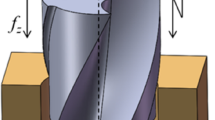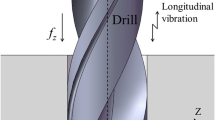Abstract
In this study, both theoretical and experimental research was conducted to investigate the role played by a difficult-to-machine material, Inconel 718, in improving the surface finish quality in drilling holes. Ultrasonic vibration technology was applied to assist with the drilling process. An axial ultrasonic vibration-assisted drilling (UAD) system was designed to determine the structural relationships between different component parts, based on which an axial UAD model was established. Abaqus finite element software was applied to perform model simulation and an analysis was conducted of the structure to find its optimal natural frequency and vibration mode. The conditions for complete geometric chip breaking based on the mechanisms of UAD and chip breaking, as well as pre-set parameters, were inferred and the theoretical domain of complete geometric chip breaking was mapped. Subsequently, a range of different parameters was applied to conduct experiments on the drilling process, from which it was established that the characteristics of chipping satisfy the conditions required for complete geometric chip breaking. Finally, under the circumstances where the parameters for the drilling process are identical and chip breaking conditions are met, UAD was found to be advantageous over conventional drilling (CD) as the former produces a more apparent chip breaking effect. Additionally, UAD can reduce the Ra value and abrasion of cutting tools, thus improving the quality of the hole drilling process.

















Similar content being viewed by others
Abbreviations
- r :
-
Drill bit radius [mm]
- Θ :
-
Rotation angle [rad]
- f r :
-
Feed rate per revolution [mm/r]
- A :
-
Amplitude [mm]
- ω :
-
Angular velocity [rad/s]
- n :
-
Rotary speed [r/min]
- f :
-
Vibration frequency [Hz]
- t :
-
Time [s]
- φ :
-
Phase angle [rad]
- V f :
-
Tool axial feed velocity [mm/s]
- K :
-
Integer part
- i :
-
Decimal part
- s :
-
Chip thickness [mm]
References
Vrabel M, Eckstein M, Mankova I (2018) Analysis of the metallography parameters and residual stress induced when producing bolt holes in Inconel 718 alloy. Int J Adv Manuf Technol 96(9-12):4353–4366
Ahmed A, Tanjilul M, Fardin A, Wong YS, Rahman M, Kumar AS (2018) On the design and application of hybrid electrical discharge and arc machining process for enhancing drilling performance in Inconel 718. Int J Adv Manuf Technol 99(5-8):1825–1837
Zou P, Xu YS, He Y, Chen MF, Wu H (2015) Experimental investigation of ultrasonic vibration assisted turning of 304 austenitic stainless steel. Shock Vib 11(1-19):1988–1996
Abu-Mahfouz I (2003) Drilling wear detection and classification using vibration signals and artificial neural network. Int J Mach Tools Manuf 43(7):707–720
Alam K, Mitrofanov AV, Silberschmidt VV (2011) Experimental investigations of forces and torque in conventional and ultrasonically-assisted drilling of cortical bone. Med Eng Phys 33(2):234–239
Kadivar MA, Akbari J, Yousefi R, Rahi A, Nick MG (2013) Investigating the effects of vibration method on ultrasonic-assisted drilling of Al/SiCp metal matrix composites. Robot Cim-Int Manuf 30(3):344–350
Chu NH, Nguyen DB, Ngo NK, Nguyen VD, Tran MD, Vu NP, Ngo QH, Tran TH (2018) A new approach to modelling the drilling torque in conventional and ultrasonic assisted deep-hole drilling processes. Appl Sci-Basel. https://doi.org/10.3390/app8122600
Baghlani V, Mehbudi P, Akbari J, Nezhad EZ, Sarhan AAD, Hamouda AMS (2016) An optimization technique on ultrasonic and cutting parameters for drilling and deep drilling of nickel-based high-strength Inconel 738LC superalloy with deeper and higher hole quality. Int J Adv Manuf Technol 82(5-8):877–888
Li Z, Zhang DY, Jiang XG, Qin W, Geng DX (2017) Study on rotary ultrasonic-assisted drilling of titanium alloys (Ti6Al4V) using 8-facet drill under no cooling condition. Int J Adv Manuf Technol 90(9-12):3249–3264
Lotfi M, Amini S (2017) Experimental and numerical study of ultrasonically-assisted drilling. Ultrasonics 75:185–193
Barani A, Amini S, Paktinat H, Tehrani AF (2014) Built-up edge investigation in vibration drilling of Al2024-T6. Ultrasonics 54(5):1300–1310
Amini S, Soleimani M, Paktinat H, Lotfi M (2017) Effect of longitudinal-torsional vibration in ultrasonic-assisted drilling. Mater Manuf Process 32(6):616–622
Chern GL, Lee HJ (2006) Using workpiece vibration cutting for micro-drilling. Int J Adv Manuf Technol 27(7-8):688–692
Li X, Meadows A, Babitsky V, Parkin R (2015) Experimental analysis on autoresonant control of ultrasonically assisted drilling. Mechatronics 29:57–66
Makhdum F, Phadnis VA, Roy A, Silberschmidt VV (2014) Effect of ultrasonically-assisted drilling on carbon-fibre-reinforced plastics. J Sound Vib 333(23):5939–5952
Azarhoushang B, Akbari J (2007) Ultrasonic-assisted drilling of Inconel 738-LC. Int J Mach Tools Manuf 47(7-8):1027–1033
Wang Y, Cao M, Zhao XR, Zhu G, McClean C, Zhao YY, Fan YB (2014) Experimental investigations and finite element simulation of cutting heat in vibrational and conventional drilling of cortical bone. Med Eng Phys 36(11):1408–1415
Paktinat H, Amini S (2017) Ultrasonic assistance in drilling: FEM analysis and experimental approaches. Int J Adv Manuf Technol 92(5-8):2653–2665
Nad M, Kolikova L, Rolnik L, Duris R (2019) Investigation of vibration effects and tool shape on edge chipping phenomenon occurring during rotary ultrasonic drilling. J Sound Vib 439:251–259
Amini S, Paktinat H, Barani A, Tehran AF (2013) Vibration drilling of Al2024-T6. Mater Manuf Process 28(4):476–480
Chang SSF, Bone GM (2009) Thrust force model for vibration-assisted drilling of aluminum 6061-T6. Int J Mach Tools Manuf 49(14):1070–1076
Nan XH, Xie LJ, Zhao WX (2016) On the application of 3D finite element modeling for small-diameter hole drilling of AISI 1045 steel. Int J Adv Manuf Technol 84(9-12):1927–1939
Sharma A, Jain V, Gupta D (2018) Characterization of chipping and tool wear during drilling of float glass using rotary ultrasonic machining. Measurement 128:254–263
Alavi SH, Cowell C, Harimkar SP (2017) Experimental and finite element analysis of ultrasonic vibration-assisted continuous-wave laser surface drilling. Mater Manuf Process 32(2):216–225
Li Z, Zhang DY, Qin W, Geng DX (2016) Removal analyses of chip and rod in rotary ultrasonic-assisted drilling of carbon fiber-reinforced plastics using core drill. J Reinf Plast Compos 35(15):1173–1190
Mandegari M, Behbahani S (2013) Experimental analysis of a novel rotary ultrasonic assisted drilling (RUAD) machine. Mater Manuf Process 28(4):481–487
Hsu I, Tsao CC (2009) Study on the effect of frequency tracing in ultrasonic-assisted drilling of titanium alloy. Int J Adv Manuf Technol 43(1-2):127–135
Liao YS, Chen YC, Lin HM (2007) Feasibility study of the ultrasonic vibration assisted drilling of Inconel superalloy. Int J Mach Tools Manuf 47(12-13):1988–1996
Ma JW, Wang FJ, Jia ZY, Xu Q, Yang YY (2014) Study of machining parameter optimization in high speed milling of Inconel 718 curved surface based on cutting force. Int J Adv Manuf Technol 75(1):269–277
Zhang DY, Wang LJ (1998) Investigation of chip in vibration drilling. Int J Mach Tools Manuf 38(3):165–176
Funding
This project is supported by the National Natural Science Foundation of China (Grant No. 51875097).
Author information
Authors and Affiliations
Corresponding author
Additional information
Publisher’s note
Springer Nature remains neutral with regard to jurisdictional claims in published maps and institutional affiliations.
Rights and permissions
About this article
Cite this article
Chen, S., Zou, P., Tian, Y. et al. Study on modal analysis and chip breaking mechanism of Inconel 718 by ultrasonic vibration-assisted drilling. Int J Adv Manuf Technol 105, 177–191 (2019). https://doi.org/10.1007/s00170-019-04155-6
Received:
Accepted:
Published:
Issue Date:
DOI: https://doi.org/10.1007/s00170-019-04155-6




